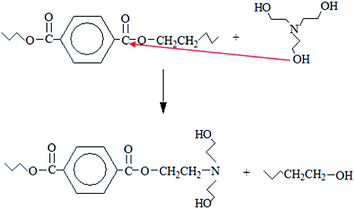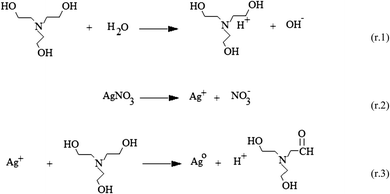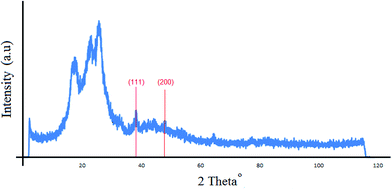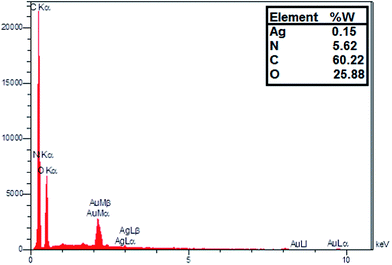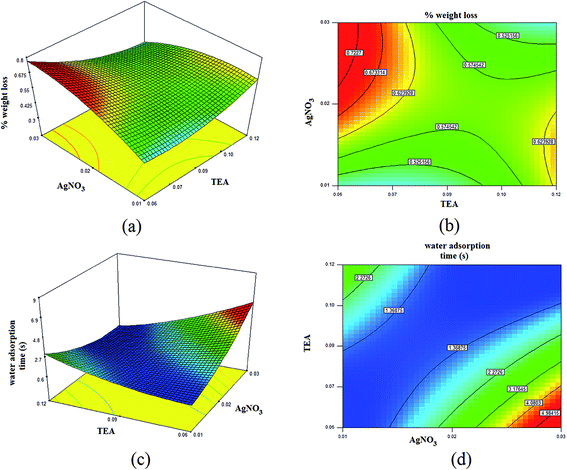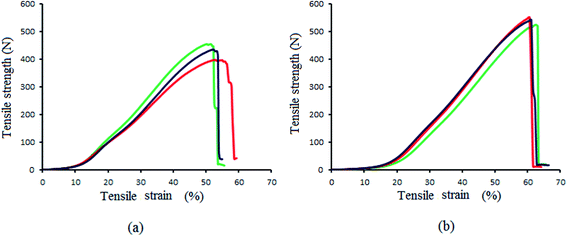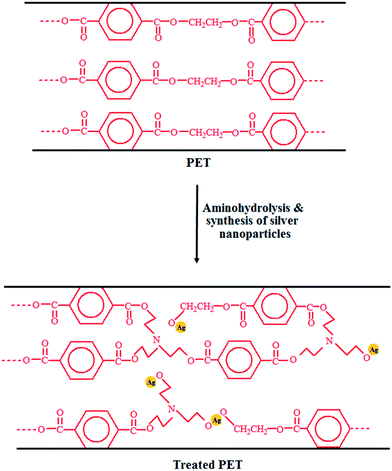Simultaneous synthesis of nano silver and activation of polyester producing higher tensile strength aminohydroxylated fiber with antibacterial and hydrophilic properties
Hajar Poortavasoly,
Majid Montazer* and
Tina Harifi
Department of Textile Engineering, Amirkabir University of Technology, Functional Fibrous Structures & Environmental Enhancement (FFSEE), Tehran, Iran. E-mail: tex5mm@aut.ac.ir; Fax: +9821 66400245; Tel: +9821 64542657
First published on 5th September 2014
Abstract
An aminohydroxylated polyester fabric with durable antibacterial activity, enhanced hydrophilicity and improved mechanical properties was prepared in one single step process. In the proposed method, synthesis of silver nanoparticles was carried out along with the aminohydrolysis of polyester fabric using triethanolamine (TEA), acting as reducing and stabilizing agent. The morphology, crystal phase, and chemical structure of the fabrics were characterized by scanning electron microscope (SEM), X-ray diffraction (XRD) and energy dispersive X-ray spectroscopy (EDX). The tensile properties and water spreading times of the treated fabrics were also measured. Moreover, central composite design based on response surface methodology was applied to study the influence of silver nitrate and TEA concentrations. It was found that silver nanoparticles with an average crystal size of 17 nm were synthesized on the fabrics treated at 130 °C. The distribution of Ag nanoparticles on the fiber surface was confirmed by SEM and EDX. Interestingly, the tensile properties of the treated samples were enhanced in comparison with the untreated fabric. Findings suggest the potential of triethanolamine in the simultaneous aminohydrolysis of polyester fabric and reduction of silver ions into silver nanoparticles, preparing a fabric with excellent antibacterial efficiency against Staphylococcus aureus and Escherichia coli, higher tensile strength and improved hydrophilicity.
1. Introduction
Polyethylene terephthalate is a semi-crystalline and semi-aromatic thermoplastic polyester produced in large scale because of its applications in the textile industry, packaging, filtration, automotive, biomedical, and many others.1 Polyester with new performance and application is often required with specific functional groups on its surface.1 Several modification methods have been developed to improve polyester characteristics without altering its bulk properties such as plasma treatment, UV irradiation, graft polymerization and chemical treatment including alkali hydrolysis and aminolysis.2–6 Aminolysis has been reported to modify the polymer surface and enhance the hydrophilicity and biocompatibility without affecting the bulk properties of the polymer.7 The amine compound attacks the polyester backbone breaking the polymer chain producing an amide group on one end and a hydroxyl group on the other. There are several reports on the influence of various monofunctional and multifunctional amines on the reactivity of polyester. For instance, the surface of polyethylene terephthalate film was chemically modified by ethylene diamine (EDA), triethylenetetramine (TETA), and tetraethylenepentamine (TEPA) for different treatment times creating different features. While TETA reacted near the surface and developed surface cracks without delamination, the highest amidation degree was produced with EDA. In addition, TEPA, the mildest reactant, generated amide groups on the surface without visible deterioration of the sample. The reactivity of these three amines was not similar and produced different chain length of polyester.7The effective role of aminolysis on polyester producing a fabric with improved wettability, comfort, handling and dye-ability has been reported.5 The aminolysis of polyester can be controlled in rate, density of modifications, and penetration depth by the amine functionality and molecular size, which especially governs the diffusion of amine molecules into the polymer.8
Silver nanoparticles have attracted considerable attention because of distinctive properties, including their antibacterial efficiency.4,9–12 Different methods have been reported for producing silver nanoparticles such as chemical reduction, hydrothermal, photochemical, laser and sol gel.13–17
The colloid of silver nanoparticles was applied on nonwoven polyester by the pad-dry-cure method.18 Silver nanoparticles were coated on polyester fabric with an ultrasonic-assisted electrolysis method creating high conductivity with low amounts of silver nanoparticles.19 In addition, triethanolamine has been used as a reducing agent in the synthesis of silver nanoparticles through chemical reduction.13 Further, polyester fabric was treated with silver nitrate and sodium hydroxide to form a silver nanolayer on the fabric surface after post-treatment with ammonia.20 In addition, polyester was functionalized with polydopamine and then electrolytically plated with silver. Silver nitrate and glucose were used as silver precursor and reducing reagent to prepare Ag nanoparticles.21 Recently, silver nanoparticles were synthesized on indigo dyed cellulosic fabric along with color reduction by reducing silver nitrate using the cellulosic chains of cotton, starch and glucose in alkaline media.22
In this paper, we describe the preparation of silver nanoparticles on the surface of polyester fibers imparting antibacterial efficiency, hydrophilicity and enhanced tensile strength. The proposed approach takes advantage of the simultaneous aminohydrolysis of polyester fabric using triethanolamine and the reduction of silver nitrate into silver nanoparticles. To investigate the effect of aminohydrolysis on enhancing the reactivity of the surface, different triethanolamine and silver nitrate concentrations were applied and their influence on hydrophilicity and weight change percentage was studied using central composite design (CCD). Apart from different characterization tests used for confirming the successful synthesis of silver nanoparticles on the fabric surface, the antibacterial activity and tensile strength of the treated fabrics were also studied.
2. Experimental
2.1. Materials and methods
A 100% polyester fabric with weight of 88 g m−2 was purchased from the local market, silver nitrate (AgNO3, extra pure >99.8%, Merck, Germany), triethanolamine (85% pure) were obtained from Petroshimi Arak Co. Methylene blue (C.I. Basic Blue 9) (Merck), nonionic surfactant (Diadavin EWN01) and an IR Elite Laboratory Dyeing Machine IRE were used.Prior to the treatment, the fabric was washed in a bath containing 1 g L−1 nonionic detergent with L![[thin space (1/6-em)]](https://www.rsc.org/images/entities/char_2009.gif) :
:![[thin space (1/6-em)]](https://www.rsc.org/images/entities/char_2009.gif) G = 40
G = 40![[thin space (1/6-em)]](https://www.rsc.org/images/entities/char_2009.gif) :
:![[thin space (1/6-em)]](https://www.rsc.org/images/entities/char_2009.gif) 1 (liquor to good ratio) at 60 °C for 20 min, rinsed with distilled water and finally dried at room temperature.
1 (liquor to good ratio) at 60 °C for 20 min, rinsed with distilled water and finally dried at room temperature.
The silver nanoparticles were synthesized on the polyester fabric treated in the bath containing a pre-calculated amount of triethanolamine (TEA) (0.06–0.12% v/v) and silver nitrate (0.01–0.03% wt/wt) based on the statistical design (Table 1). The process was carried out at 130 °C for 1 h using HT-IR device. A polyester fabric that was treated only with distilled water at 130 °C for 1 h in the same device was considered as the control sample. Finally, the treated fabrics were washed with distilled water and dried at room temperature.
| Run | TEA (%v/v) | AgNO3 (%wt/wt) | ΔW (%) | Water spreading time (s) |
|---|---|---|---|---|
| 1 | 0.09 | 0.01 | −0.40 | 1.9 |
| 2 | 0.09 | 0.02 | −0.60 | 1.4 |
| 3 | 0.11 | 0.03 | −0.50 | 1.0 |
| 4 | 0.07 | 0.01 | −0.49 | 0.9 |
| 5 | 0.12 | 0.02 | −0.60 | 1.1 |
| 6 | 0.11 | 0.01 | −0.60 | 2.5 |
| 7 | 0.06 | 0.02 | −0.69 | 2.5 |
| 8 | 0.09 | 0.02 | −0.57 | 1.2 |
| 9 | 0.07 | 0.03 | −0.70 | 4.9 |
| 10 | 0.09 | 0.02 | −0.60 | 1.3 |
| 11 | 0.09 | 0.03 | −0.50 | 3.6 |
| Control | 0.00 | 0.00 | 0.00 | 3.0 |
2.2. Test method
The structural characterization of the silver nanoparticles synthesized on polyester fabrics was performed by X-ray diffraction (EQuniox3000, INEL, France) with nickel-filtered Cu Kα radiation to study the presence and the crystalline structure of the adsorbed nanoparticles on the fabric surface and to estimate the size of the crystalline structure. The morphology and size of silver nanoparticles were studied by a scanning electron microscope (SEM) equipped with energy-dispersive spectroscopy (EDX) to characterize elemental composition.Moreover, an inductively coupled plasma optical emission spectrometer (ICP-OES, Varian, Australia) was used to measure the concentration of Ag in the fabric treated with an optimum amount of silver nitrate and triethanolamine. Prior to ICP analysis, a certain weight of fabric was cut into small pieces and heated in nitric acid solution at 85 °C for 4 h. The obtained solution was cooled and diluted to a certain volume. The concentration of silver in mg per kg of the solid sample was recorded.
Considering the effect of aminohydrolysis on the weight reduction of the treated fabrics, the percentage of weight change due to the treatment (ΔW) was determined according to eqn (1):
 | (1) |
Regarding the surface modification of samples through aminohydrolysis, the alteration in the wettability of the treated samples was evaluated by measuring the time required for a water droplet to adsorb and spread on the fabric surface according to AATCC Test Method 79-2000. The fabrics were placed horizontally without crease, and a drop of 0.1 mL distilled water was placed on the fabric from 1 cm height. The time required for the droplet to spread completely on the fabric surface was measured using a stopwatch. The measurement was repeated 10 times and the average value was recorded.
Quantitative antibacterial efficiency of the treated fabric was determined against Staphylococcus aureus (ATCC 6538) as Gram-positive and Escherichia coli (ATCC 8739) as Gram-negative bacteria according to the AATCC100 guideline. Briefly, a fresh culture of each bacterial strain was prepared on nutrient agar (18 h at 37 °C). Bacteria were cultured, washed three times and suspended in normal saline to an OD620 of 0.1, which is equal to 1.5 × 108 CFU mL−1. Subsequently, a dilution of 1![[thin space (1/6-em)]](https://www.rsc.org/images/entities/char_2009.gif) :
:![[thin space (1/6-em)]](https://www.rsc.org/images/entities/char_2009.gif) 10 from each bacterial suspension was prepared. The treated and untreated (control) fabrics with equal dimensions were separately cut to small pieces (∼0.5 × 0.5 cm), placed in sterile 50 mL polystyrene conical tubes (Jet-Biofil, Canada) and sterilized in an autoclave (15 min at 121 °C). Fabrics were separately inoculated with a bacterial suspension (containing 106 CFU mL−1) and incubated for 18 h at room temperature. After the exposure time, 20 mL of normal saline was added to each tube and stirred vigorously for 2 min. Three serial dilutions of 1
10 from each bacterial suspension was prepared. The treated and untreated (control) fabrics with equal dimensions were separately cut to small pieces (∼0.5 × 0.5 cm), placed in sterile 50 mL polystyrene conical tubes (Jet-Biofil, Canada) and sterilized in an autoclave (15 min at 121 °C). Fabrics were separately inoculated with a bacterial suspension (containing 106 CFU mL−1) and incubated for 18 h at room temperature. After the exposure time, 20 mL of normal saline was added to each tube and stirred vigorously for 2 min. Three serial dilutions of 1![[thin space (1/6-em)]](https://www.rsc.org/images/entities/char_2009.gif) :
:![[thin space (1/6-em)]](https://www.rsc.org/images/entities/char_2009.gif) 10 from each sample were prepared, and 0.1 mL from each dilution was inoculated on Mueller-Hinton agar and spread on the surface thoroughly. Plates were incubated for 18 h at 37 °C, then colonies were counted and the total CFU mL−1 was determined for each experiment. The antibacterial efficiency was calculated according to eqn (2).
10 from each sample were prepared, and 0.1 mL from each dilution was inoculated on Mueller-Hinton agar and spread on the surface thoroughly. Plates were incubated for 18 h at 37 °C, then colonies were counted and the total CFU mL−1 was determined for each experiment. The antibacterial efficiency was calculated according to eqn (2).
 | (2) |
In addition, to evaluate the effect of treatment on the mechanical properties of the samples, the tensile strength was tested by using an Instron instrument with a gauge length of 10 cm and an extension rate of 100 mm min−1 for three replicates, and the average value was recorded.
3. Results and discussion
3.1. Synthesis of Ag nanoparticles in the presence of TEA
The method employed to introduce hydroxylamine functional groups on the polyester surface was aminohydrolysis reaction using triethanolamine. This reaction forms a new amide bond and introduces free amino and alcohol groups on the surface of the polyester fibers, according to Scheme 1.1The reaction of polyester with hydroxylamines leads to the interaction of one hydroxyl groups of TEA with an ester bond of polyester. Monoethanolamine (MEA) has two nucleophilic centers with the electronegativity of nitrogen being higher than that of oxygen. Thus, the attack of MEA on polyester is from the nitrogen. However, when polyester reacts with triethanolamine, the hydroxyl groups attack the polyester chain due to steric hindrance around the amine group. Therefore, aminolysis of polyester with alkanolamines leads to oligoesters containing hydroxyl as the terminal groups (Scheme 1).7,24
The triethanolamine molecule contains three (–CH2OH) groups that act as the reducing agent. In aqueous solution, TEA hydrolyzes in water (Kb = 5.8 × 10−7) generating OH− (Scheme 2, r.1), producing the initial pH ≈ 10.10
According to Scheme 2 r.2, silver nitrate ionized to Ag+ and NO3− in water, and silver ions were reduced to silver metal (Ag0) during the oxidation of the CH2CH2OH groups in TEA to –CH2CHO (Scheme 2, r.3).10
Ag nanoparticles coordinate with hydroxyl groups on polyester fabric and substitute with hydrogen (reaction 4).25
| R–OH + Ag0 → R–OAg + 1/2 H2 | (r.4) |
3.2. XRD pattern
According to Fig. 1, the successful synthesis of silver nanoparticles on the aminohydroxylated polyester fabric was confirmed by the characterization of peaks at 2θ angles of 38.21° and 44.29° attributed to (111) and (200) facets, respectively, in addition to the main peak of the original polyester fabric at 2θ = 17°–25°. The crystallite size of the Ag nanoparticles is calculated to be around 17 nm using the Scherrer's equation5 and from the width of the peak at 2θ angle 38.21°.3.3. SEM and EDX analysis
According to SEM images, while the surface of the control sample is smooth (Fig. 2a), the synthesized Ag nanoparticles are distributed on the surface of the treated fabric (Fig. 2b–d). The images at higher magnification (Fig. 2c and d) indicate the presence of spherical-shaped particles. According to Fig. 2c, the average size of particles was estimated to be around 54.5 nm. However, there are some other particles that are highly aggregated forming larger particles. Because of the low diffusion rate of triethanolamine acting on the surface layer of polyester,26 no distinctive voids can be seen on the surface of the treated fabric (Fig. 2b–d). Therefore, aminohydrolysis of polyester fabric along with the synthesis of silver nanoparticles did not damage the fibers.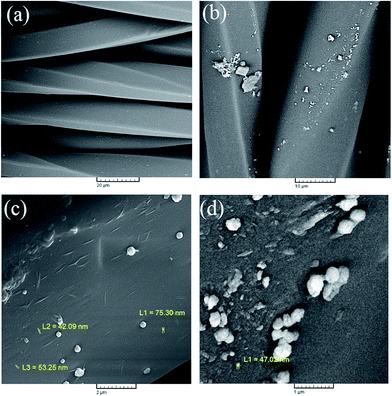 | ||
Fig. 2 SEM images of (a) control and (b–d) treated samples. Images are at 1600×, 3000×, 15![[thin space (1/6-em)]](https://www.rsc.org/images/entities/char_2009.gif) 000× and 30 000× and 30![[thin space (1/6-em)]](https://www.rsc.org/images/entities/char_2009.gif) 000× magnifications from a to d, respectively. 000× magnifications from a to d, respectively. | ||
As shown in Fig. 3, the successful synthesis of silver nanoparticles on the treated sample was further confirmed by the presence of the silver element in the EDX spectrum. Moreover, apart from the carbon and oxygen related to the polyester substrate, nitrogen is detected in the spectrum, confirming the simultaneous aminohydrolysis of the fabric introducing the amino and hydroxyl functional groups to the polyester surface.
3.4. Weight change percentage and hydrophilicity
Because of the simultaneous aminohydrolysis of polyester surface along with the synthesis of silver nanoparticles, and considering the effect of aminohydrolysis on surface modification and wettability, a statistically-approached experimental design according to central composite design (CCD) was used to investigate the impact of triethanolamine and silver nitrate concentrations on weight change percentage and hydrophilicity. The design matrix was an 11-run CCD with two factors and the statistical treatment combinations of the test variables (TEA and AgNO3 concentrations) along with the measured response values, expressed as water spreading time and ΔW%, are summarized in Table 1.Because of the breakage of the ester chains of polyester, the formation of oligomers and other low molar mass fragments removed from the fibers during aminohydrolysis,1 all the treated samples indicated weight loss (negative coefficient of ΔW% values). Therefore, the positive amount of ΔW% was considered to be the weight change and greater ΔW% indicated more weight loss.
The quadratic effects of TEA and AgNO3 concentrations on weight loss and wettability can be seen from three-dimensional response surface graphs shown in Fig. 4a and c, respectively. Fig. 4b and d also indicates a two-dimensional representation of the responses for the two mentioned factors. The higher and lower response values are shown with red and green colors, respectively. According to Fig. 4a, the effect of TEA concentration on weight loss percentage was dependent on the amount of the applied silver nitrate. Increasing the TEA content in the preparation bath at low content of AgNO3 (0.01% wt/wt) led to more weight loss, possibly due to more nucleophiles attacking the ester bonds of polyester in higher amounts of triethanolamine.
On the other hand, an increase in TEA concentration at higher content of AgNO3 (0.03% wt/wt) decreased the obtained weight loss due to the synthesis and adsorption of more silver nanoparticles on the treated fabrics.
A similar trend was observed for the relation between weight loss and silver nitrate concentration with varying the TEA content. Fig. 4a demonstrates the increment in weight loss with an increase in AgNO3 content at low TEA content. Silver ions may be adsorbed on the nucleophiles of the treated polyester fabric decreasing the negative charge of the surface and enhancing the TEA attacks. However, more TEA led to more silver nanoparticles synthesized and adsorbed on the fabric surface, reducing the weight loss percentage.
As can be seen in Fig. 4c, although increasing TEA at a low level of silver nitrate led to a slight increase in wetting time, a sharp reduction in the water spreading time was obtained at higher concentrations of AgNO3 (0.03% wt/wt). The surface chemical modification of polyester fabrics by aminohydrolysis has usually been used to change the surface characteristics without altering the bulk structure and forming the terminal groups of OH on the surface of polyester. The hydroxylamines have been proven to enhance the hydrophilic property and basicity of the polyester surface.1,6,20 In addition, Ag nanoparticles adsorbed on the polyester surface can adsorb water molecules by ionic attraction.
Fig. 4c shows that the wettability declined with an increase in silver nitrate content from 0.01% to 0.03% wt/wt at a low level of TEA. In reverse, adding more TEA up to 0.12% v/v caused an increase in hydrophilicity due to the creation of more hydrophilic functional groups on the surface of the treated samples. It is worth noting that in the current study both water spreading and water adsorption have influenced the wettability. Due to capillary action water molecules spread on the control sample, while for the treated sample water molecules could be adsorbed by the introduced hydrophilic functional groups along with spreading.27
Finally, optimization was carried out to obtain the best combination of the factors to achieve the maximum hydrophilicity and weight change. Because higher wettability and weight change can be attributed to the enhanced aminohydrolysis and surface activity of the treated fabrics, the software suggested the optimized model factors of TEA and AgNO3 at 0.11% v/v and 0.02% wt/wt, respectively.
According to the results obtained from the ICP test, silver concentration on fabric treated with an optimum amount of silver nitrate and triethanolamine was 5.91 mg kg−1. A low amount of silver on the treated fabric was beneficial for obtaining excellent antibacterial efficiency and enhanced tensile strength with negligible color change.
3.5. Antibacterial efficiency
Bacterial growth for each sample was counted and observations are as follows: fabric treated with silver nanoparticles and inoculated with Staphylococcus aureus showed no growth, while the corresponding untreated blank fabric (control sample) showed a mean growth of 3.24 × 106 CFU mL−1. According to the dilution of 1![[thin space (1/6-em)]](https://www.rsc.org/images/entities/char_2009.gif) :
:![[thin space (1/6-em)]](https://www.rsc.org/images/entities/char_2009.gif) 100, which showed no growth, the fabric reduced the bacterial count to more than 4 log units and its antibacterial activity is ≥99.99%. Exposure of Escherichia coli to nano silver treated fabric also resulted in growth inhibition in cultured dilutions, while the bacterial count for the blank sample (control sample) was 1.43 × 106 CFU mL−1. There is a 4 log unit reduction for Escherichia coli similar to Staphylococcus aureus with an antibacterial efficiency of ≥99.99%. The antibacterial efficiency of the control and treated fabrics against Staphylococcus aureus and Escherichia coli bacteria is shown in Fig. 5a and b, respectively.
100, which showed no growth, the fabric reduced the bacterial count to more than 4 log units and its antibacterial activity is ≥99.99%. Exposure of Escherichia coli to nano silver treated fabric also resulted in growth inhibition in cultured dilutions, while the bacterial count for the blank sample (control sample) was 1.43 × 106 CFU mL−1. There is a 4 log unit reduction for Escherichia coli similar to Staphylococcus aureus with an antibacterial efficiency of ≥99.99%. The antibacterial efficiency of the control and treated fabrics against Staphylococcus aureus and Escherichia coli bacteria is shown in Fig. 5a and b, respectively.
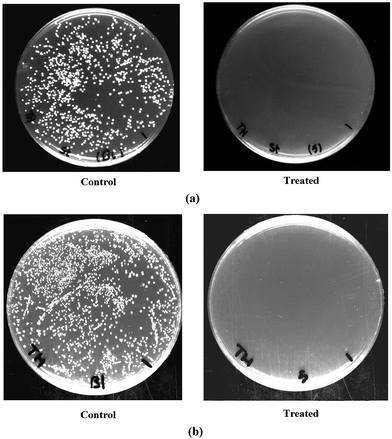 | ||
| Fig. 5 Antibacterial efficiency of control and treated samples against (a) Staphylococcus aureus and (b) Escherichia coli. | ||
Despite the deficiency of a control sample to prevent the bacterium growth, the Ag nanoparticles treated fabric clearly improved the antibacterial activity to ≥99.99% reduction of bacteria. The potentiating effect of silver nanoparticles is due to metal ions and their small particle size and high specific surface area, which allow close interaction with microbial membranes.28 Damage to the lipids, proteins and DNA of the microorganisms are the main antibacterial mechanisms of silver nanoparticles.29
A fabric was also treated with 0.11% v/v triethanolamine alone with the same conditions with an antibacterial efficiency of ≥99.99% against both Staphylococcus aureus and Escherichia coli bacteria. The antibacterial activity of polyols has been reported in literature to be related to the hydrophilic nature of the polyols, which causes the desiccating of the microbes, depriving the bacteria the required moisture and/or absorbing resulted in dispersing the bacteria membrane.30
Although the treatment with triethanolamine at the applied concentration resulted in complete bacterial reduction, in this study our focus was on the use of triethanolamine as a reducing agent for the formation of silver nanoparticles. Silver nanoparticles are known as antibacterial agents capable of killing most common pathogenic bacteria. The optimized sample in this study was introduced based on weight change and water spreading time; we did not study the minimum concentrations for obtaining the antibacterial activity. It is obvious that a fabric coated with silver nanoparticles can be more effective in antibacterial tests in a short time and against other bacteria and fungi, which were not studied in this paper. In addition, silver coated fabrics were superior to samples treated only with triethanolamine regarding their improved tensile strength.
3.6. Tensile strength
Considering the possible detrimental effect of aminohydrolysis of polyester fabric on mechanical properties, tensile strength of the treated fabric at the optimum concentration of TEA and AgNO3 was measured and the result was compared to the maximum load of control sample (Table 2 and Fig. 6). Interestingly, the introduction of silver nanoparticles into the structure of polyester fiber improved the tensile strength of the treated fabric to about 25%, possibly due to the cross-linking of the nanoparticles between the polymer chains of polyester fibers, as shown schematically in Fig. 7. Enhanced tensile properties of different textile materials through the in situ synthesis of nanoparticles, such as cupper and iron oxide, has been reported in literature as a result of the cross-linking effect.31,324. Conclusion
Aminohydroxylated polyester fabric with excellent antibacterial efficiency against Staphylococcus aureus and Escherichia coli bacteria, higher wettability and improved tensile strength with no visible color change was successfully obtained by the simultaneous aminohydrolysis of polyester and the synthesis of silver nanoparticles on the fabric surface. The proposed novel method had no additional step for the pre-treatment of the polyester fabric to enhance the adsorption properties. Triethanolamine in the preparation procedure was responsible for the simultaneous reduction of silver ions into silver nanoparticles and the surface modification of polyester, introducing hydroxylamine functional groups on the fiber surface and thereby enhancing the hydrophilicity.Notes and references
- L. Bech, T. Meylheuc, B. Lepoittevin and P. Roger, J. Polym. Sci., Part A: Polym. Chem., 2007, 45, 2172 CrossRef CAS
.
- N. Inagaki, K. Narushim, N. Tuchida and K. Miyazaki, J. Polym. Sci., Part B: Polym. Phys., 2004, 42, 3727 CrossRef CAS
.
- A. Hebeish, S. E. Shalaby and A. M. Bayazeed, J. Appl. Polym. Sci., 1982, 27, 3683 CrossRef CAS
.
- V. Allahyarzadeh, M. Montazer, N. Hemmatinejad and N. Samadi, J. Appl. Polym. Sci., 2013, 129, 892 CrossRef CAS
.
- S. A. Holmes, J. Appl. Polym. Sci., 1996, 61, 255 CrossRef CAS
.
- Y. Zhu, Z. Mao and C. Gao, RSC Adv., 2013, 3, 2509 RSC
.
- X. Zhong, Z. Lu, P. Valtchev, H. Wei, H. Zreiqat and F. Dehghani, Colloids Surf., B, 2012, 93, 75 CrossRef CAS PubMed
.
- M. Avadanei, M. Drobot, I. Stoic, E. Rusu and V. Barboiu, J. Polym. Sci., Part A: Polym. Chem., 2010, 48, 5456 CrossRef CAS
.
- S. Agnihotri, S. Mukherji and S. Mukherji, RSC Adv., 2014, 4, 3974 RSC
.
- P. Sepahi Rad, M. Montazer and M. Rahimi, J. Appl. Polym. Sci., 2011, 122, 1405 CrossRef CAS
.
- C. Greulich, D. Braun, A. Peetsch, J. Diendorf, B. Siebers, M. Epple and M. Köller, RSC Adv., 2012, 2, 6981 RSC
.
- T. Torsten, M. G. Fouda and B. Mahltig, Appl. Surf. Sci., 2010, 256, 2337 CrossRef PubMed
.
- M. Montazer, F. Alimohammadi, A. Shamei and M. Rahimi, Carbohydr. Polym., 2012, 87, 1706 CrossRef CAS PubMed
.
- K. Wang, Y. Wu, H. Li, M. Li, D. Zhang, H. Feng and H. Fan, RSC Adv., 2014, 4, 5130 RSC
.
- M. Montazer, A. Shamei and F. Alimohammadi, Prog. Org. Coat., 2012, 74, 270 CrossRef CAS PubMed
.
- N. Lkhagvajav, I. Yaşa, E. Celik, M. Koizhaiganova and O. Sari, Dig. J. Nanomater Bios., 2011, 6, 149 Search PubMed
.
- Z. Xu and G. Hu, RSC Adv., 2012, 2, 11404 RSC
.
- H. J. Lee and S. H. Jeong, Text. Res. J., 2004, 74, 442 CrossRef CAS PubMed
.
- Y. Lu, S. Jiang and Y. Huang, Surf. Coat. Technol., 2010, 204, 2829 CrossRef CAS PubMed
.
- M. Montazer and V. Allahyarzadeh, Ind. Eng. Chem. Res., 2013, 52, 8436 CrossRef CAS
.
- W. Wang, W. Cheng, M. Tian, H. Zou, L. Li and L. Zhang, Electrochim. Acta, 2012, 79, 37 CrossRef CAS PubMed
.
- A. Sadeghian Maryan, M. Montazer and T. Harifi, J. Polym. Res., 2013, 20, 89 CrossRef PubMed
.
- A. Hebeish, M. E. El-Naggar, M. G. Fouda, M. A. Ramadan, A. Al-Deyab Salem and M. H. El-Rafie, Carbohydr. Polym., 2011, 86, 936 CrossRef CAS PubMed
.
- S. Heidari and K. Tahvildari, Journal of Applied Chemical Research, 2013, 7, 33 Search PubMed
.
- R. T. Morison and R. N. Boyd, Organic Chemistry, Prentice Hall, USA, 1983, vol. 4, pp. 486–487 Search PubMed
.
- Y. Mansourpanah and A. Gheshlaghi, J. Polym. Res., 2012, 19, 13 CrossRef PubMed
.
- S. Hashemizad, M. Montazer and A. Rashidi, J. Appl. Polym. Sci., 2012, 125, 1176 CrossRef CAS
.
- A. Jafari, M. Ghane and S. Arastoo, Afr. J. Microbiol. Res., 2011, 5, 5465 CAS
.
- T. Harifi and M. Montazer, Ind. Eng. Chem. Res., 2014, 53, 1119 CrossRef CAS
.
- T. L. Vigo and K. K. Leonas, Text. Chem. Color. Am. Dyest. Rep., 1999, 1, 42 CAS
.
- T. Harifi and M. Montazer, J. Mater. Chem. B, 2014, 2, 272 RSC
.
- Z. Komeily-Nia, M. Montazer and M. Latifi, Colloids Surf., A, 2013, 439, 167 CrossRef CAS PubMed
.
| This journal is © The Royal Society of Chemistry 2014 |

